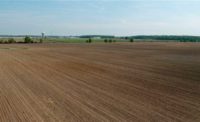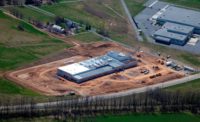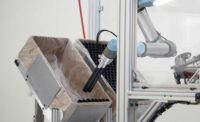Digital disruption tools provide a glimpse of the future factory
Day-long event at UI Labs' DMDII features some cutting-edge technology to digitally transform the factory floor.

Manufacturing might have the reputation of being old, dirty and generally, antiquated. But that image couldn’t be farther from what is represented at the Digital Manufacturing and Design Innovation Institute located in Chicago.
The DMDII, a UI Labs collaboration, hosted a one-day experiential learning workshop to discuss, display and inspire participants about how digital technologies can impact the factory floor. The event was designed to introduce new digital tools available now that can transform the manufacturing environment and redefine how people, processes and equipment function in the future plants.
The following are some of the highlights from the digital tools demonstrated:
Light Guide Systems
OPS Solutions’ Light Guide Systems platform uses augmented reality technology to help manufacturers optimize their operations by reducing errors and cycle times as well as decreasing training costs. This solution demonstrates how using a combination of overhead projectors, motion detectors and monitors can digitize even manual processes in their work environment.
An operator stands at a workstation and must follow a sequence script, such as grabbing a part from the correct bin. If sensors detect the right part was picked, the operator can advance to the next step, but if the wrong part was picked, alerts will go off and the process will stop until the step is done correctly.
“There is what happens on the plant floor, and then what people think what happens,” says Paul Pierson, manager of manufacturing quality at UI LABS. “With this technology, operator errors are taken out of the process.”
Tulip
Tulip brings the power of Industrial IoT and advanced analytics to the industry through its Manufacturing Apps Platform. “
We provide a first-class tool to build apps on the floor so you can get data and make use of it,” says Rony Kubat, the co-founder of Tulip.
Often times manufacturing can involve a lot of manual processes, such as relying on paper-based work instructions, which can result in “siloed information” that can be hard to share.
“And machines’ user interfaces suck, they are made for machines, not people,” Kubat says. Tulip’s goal is to enable the flow of operation and bring all parts of the factory together in a holistic system to help reduce errors, decrease training costs, increase productivity and save implementation costs.
“Out of the data collected, engineers can recognize what is going on and then change the plant process for the better,” Kubat says.
Upskill
Upskill’s Skylight augmented reality platform connects workers to management, maintenance and information enabling them to do their jobs faster and more effectively.
“In Industry 4.0, machines know what’s wrong, so it’s our job to make sure the humans know what’s wrong,” says Andrew Sugaya, director of partnerships for Upskill.
Through its wearable, hands-free display tools in the form of smart glasses, Skylight can help provide operators with step by step instructions in their line of sight and not require them to look away or tap a laptop. The worker can move through prompts with voice commands, smart glasses' touch pad and the head tracking interface.
Also, the device has the ability to communicate information between two parties; for example, an operator who is facing an equipment problem and the maintenance personnel that can guide the operator through the fix.
“The video calls and snapshots taken with the smart glasses can allow management to see what the operator sees,” says Sugaya.
This can cut time and manpower down by allowing information to be pushed directly to the equipment user via text, images and/or videos.
VisionThree
VisionThree uses virtual reality (VR), augmented reality and mixed reality technology to help manufacturers improve training, customer support, marketing and recruitment.
To move beyond more traditional training methods, such as PowerPoint, PDFs and videos, VisionThree is using immersive technology to provide more effective training. With VR, VisionThree has found that trainees can understand key educational components more clearly. Plus, trainees are allowed to learn “hands-on” while in a consequence-free environment, thus can more easily learn from their mistakes.
VR can also be a great tool for planning plant floor manufacturing processes and equipment layout, says Jeff White, business developer for VisionThree. He says one food manufacturer has used the technology to help with its pest management and determine where best to place traps in its warehouse.
About UI LABS and DMDII
UI LABS was formed to bring universities, industry and civic organizations together to drive innovation and tech-based economic development in the Midwest. The organization opened nearly 100,000 square feet of demonstration and collaboration space in Chicago in May 2015. Since then, more than 300 partners from industry, academia and government have joined the organization.
UI LABS’ primary mission is to transform industries using digital technologies, and one of its platforms, the DMDII, focuses on how manufacturing will change in the next few years. DMDII functions as a world-class, first of its kind manufacturing hub that is designed to provide US factories the tools, software and expertise they need to manufacture more efficiently in order for US companies to compete on the world stage.
Looking for a reprint of this article?
From high-res PDFs to custom plaques, order your copy today!







